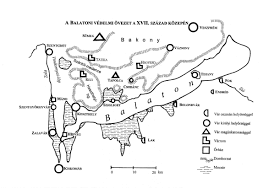October 1570: the Hungarian Borderland warriors defeated the Ottomans at Alsóörs
We know from contemporary payrolls that 95% of the Ottoman soldiers garrisoned in the castles of the Ottoman-occupied lands of Hungary were not ethnically Turkish. In fact, there were many South Slavic and Albanian mercenaries among them. In most cases, they were paid regularly and were not as poor as the Hungarian warriors.

It is also known that there were other mercenaries employed by the Ottomans who were not paid regularly. These irregular soldiers were usually sent to raid deep behind the Hungarian lines to weaken the defenses. They lived on plunder.
In this particular case, all we know is that the poorly paid Ottoman soldiers of the Sanjak Bey of Székesfehérvár, a total of 900 horsemen, attacked the highlands around Lake Balaton. They aimed to plunder and pillage.

The news of the attack alarmed the Hungarian soldiers in the castles of Pápa and Veszprém. Bornemissza János and Török Ferenc immediately set out from Pápa, leading 200 hussars and 100 infantrymen (Hajdú soldiers). Thury Márton joined them from Veszprém Castle, but we do not know the size of his unit.
Soon the Hungarian scouts told them that the bulk of the Ottoman army, about 700 horsemen, were in their camp in the village of Alsőörs on the shores of Lake Balaton. They said that Alaj-Bey Mustapha, the Vice-Bey of the Bey of Székesfehérvár, was with them, along with other Aghas, namely Amhát, Dzsafer, Murat, Kizefer, Alega, Bertham, and Hamza, not forgetting Chief-Voivode Murat.
Captain Bornemisza János and Captain Thury Márton set out to attack them with 100 hussars and 100 infantry. Captain Török Ferenc of Pápa Castle stayed behind with 100 hussars as a reserve.

It was evening and it was cold. The Hungarians saw that the main Ottoman army of 700 was between the gardens of Alsóörs and Lake Balaton. Bornemisza sent ten of his hussars as bait (‘martalék’ in Hungarian) to lure the Turks out of their camp. But the enemy didn’t follow them. They were deployed in battle order and waited for the Hungarians to attack.

As darkness fell, the Hungarians sounded a terrible battle cry and rushed towards the Ottoman line. After an hour of bloody hand-to-hand combat, the Turks were still like a stone wall. It was then that 100 Hajdú soldiers ran to the Ottoman side and attacked the horsemen with a deadly volley of musketry. The enemy line was scattered and the Ottoman horsemen began to flee.
The Pápa hussars, led by Bornemissza, chased them for two miles and cut down many of them. Many of the fleeing enemies were forced into Lake Balaton.

There were 200 Ottoman horsemen who were not there because they were busy plundering the nearby villages. When they heard of the defeat, they left their prisoners and booty behind and tried to flee.
Meanwhile, 25 Ottoman scouts who had just returned from their mission encountered the 100 hussars of Török Ferenc, who were riding in the opposite direction. The surprised enemy horsemen were slaughtered on the spot. The whole battle lasted until the middle of the night, but the Hungarians lost no one and had many wounded. The hunt continued the next day when the scattered enemy horsemen were pursued. The Pápa hussars returned with 22 prisoners, many horses, and many severed heads.

The Veszprém soldiers took 7 prisoners. Agha Amhát died in the battle, but Agha Dzsafer and Agha Murat managed to escape on foot. The captured soldiers said that they were just poor boys and that they only went on raids because they were hungry. Bornemissza János and some of his officers were sent to the Habsburg king. They gave him four flags and a Turkish officer. There was a Hungarian officer named Pribék Imre who had distinguished himself in the battle, so he was rewarded by Archduke Charles Habsburg with 50 gold forints.
(Sources: Szibler Gábor and Veress D. Csaba: „Várak a Balaton körül. 122-123”)
Dear Readers, I can only make this content available through small donations or by selling my books or T-shirts.
If you like my writings, please feel free to support me with a coffee here:
You can check out my books on Amazon or Draft2Digital, they are available in hardcover, paperback, or ebook:
https://www.amazon.com/dp/198020490X
or at https://books2read.com/b/boYd81
 “33 Castles, Battles, Legends” (Paperback)
“33 Castles, Battles, Legends” (Paperback)

My work can also be followed and supported on Patreon: Become a Patron!http://Become a Patron!


https://hungarianottomanwars.myspreadshop.com/

https://hungarianottomanwars.myspreadshop.com/all


